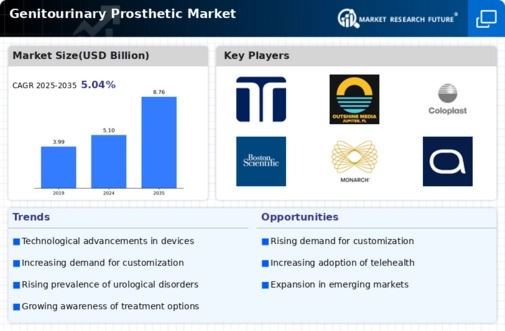Increased Awareness and Acceptance
There is a growing awareness and acceptance of genitourinary prosthetics among both patients and healthcare providers, which serves as a significant driver for the Genitourinary Prosthetic Market. Educational initiatives and advocacy efforts have contributed to reducing stigma associated with urological disorders, encouraging individuals to seek treatment. As more patients become informed about available options, the demand for prosthetic devices is likely to rise. This shift in perception is crucial, as it not only impacts patient choices but also influences healthcare policies and funding for research and development in this sector.
Aging Population and Lifestyle Changes
The aging population, coupled with lifestyle changes, is a critical factor driving the Genitourinary Prosthetic Market. As individuals age, they are more susceptible to various urological conditions, which increases the need for prosthetic solutions. Additionally, lifestyle factors such as obesity and sedentary behavior contribute to the prevalence of these disorders. The World Health Organization has indicated that by 2050, the number of people aged 60 years and older will double, further amplifying the demand for effective treatment options. This demographic shift presents a substantial opportunity for market growth as healthcare systems adapt to meet the needs of an older population.
Rising Incidence of Urological Disorders
The increasing prevalence of urological disorders, such as erectile dysfunction and urinary incontinence, is a primary driver for the Genitourinary Prosthetic Market. As populations age, the incidence of these conditions tends to rise, leading to a greater demand for prosthetic solutions. According to recent data, approximately 30 million men in the United States experience erectile dysfunction, highlighting a substantial market opportunity. Furthermore, urinary incontinence affects millions globally, necessitating innovative prosthetic devices. This growing patient population is likely to propel the market forward, as healthcare providers seek effective solutions to improve quality of life for affected individuals.
Technological Innovations in Prosthetics
Technological advancements in materials and design are significantly influencing the Genitourinary Prosthetic Market. Innovations such as biocompatible materials and advanced manufacturing techniques have led to the development of more effective and durable prosthetic devices. For instance, the introduction of inflatable penile prostheses has revolutionized treatment options for erectile dysfunction, offering patients improved functionality and satisfaction. The market is projected to grow as these technologies continue to evolve, with estimates suggesting a compound annual growth rate of over 6% in the coming years. This trend indicates a robust demand for cutting-edge solutions that enhance patient outcomes.
Rising Investment in Healthcare Infrastructure
Investment in healthcare infrastructure is another significant driver for the Genitourinary Prosthetic Market. Governments and private entities are increasingly allocating resources to enhance healthcare facilities and services, particularly in developing regions. This investment is likely to improve access to advanced medical technologies, including genitourinary prosthetics. As healthcare systems expand and modernize, the availability of these devices is expected to increase, thereby driving market growth. Furthermore, initiatives aimed at improving surgical outcomes and patient care are likely to foster innovation and competition within the industry, ultimately benefiting patients.


















Leave a Comment